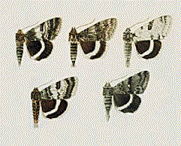Papers in the Biological Sciences

Alan Bond Publications
Document Type
Article
Date of this Version
1983
Abstract
The foraging behavior of lacewing larvae (Chrysopa carnea Stephens, Chrysopidae, Neuroptera) on vertical lucite rods was observed under a variety of experimental conditions to investigate the decision processes responsible for the distribution of foraging effort. Food deprivation increased the duration of searching on all parts of the rod, whereas contact with prey at the rod tip induced only a local enhancement of searching activity. Searching at the rod tip did not decline with repeated trials on the same rod, but the duration of searching on the rest of the rod was reduced, evidently reflecting recognition and avoidance of previously-searched substrates. There were indications that the larvae compensated for changes in the surface area, radius of curvature, and length of the rod. Searching patterns at the tip and on the rest of the rod proved to be independently modifiable, suggesting a two-tiered hierarchy of foraging decisions. The total duration of the search depended primarily on the pattern of vertical movement and the number of reascents, rather than the searching effort per unit area. Evidence of a negative geotaxis was found only during the initial ascent of the rod, and no sequential pattern in the lengths of vertical excursions was observed. The decision process appeared to involve a combination of variable control factors interacting with a generally constant, random probability of change or reversal of direction. The resulting investment of foraging time corresponded surprisingly well with expectations derived from optimal foraging theory, thereby testifying to the power of approximate, semi-random decision processes.


Comments
Published in Animal Behaviour 31 (1983), pp. 990–1004. Copyright © 1983 Elsevier. Used by permission.